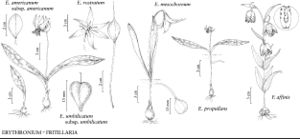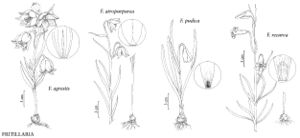Fritillaria
Sp. Pl. 1: 303. 1753.
Gen. Pl. ed. 5, 144. 1754.
Herbs, perennial, bulbose; bulbs with 1–several large fleshy scales and 0–many small scales (often called rice-grain bulblets). Stem 1, erect, simple, absent in nonflowering individuals. Leaves alternate or whorled proximally in some species, sessile; blade linear to ± ovate; nonflowering individuals with single elliptical, ovate, or obovate “bulb-leaf.” Inflorescences loosely racemose, bracteate; bracts leaflike. Flowers 1–many, usually nodding, 3-merous; perianth hypogynous, campanulate or cupulate; tepals 6, in 2 similar whorls, distinct, nectaries present on all tepals, but better developed on inner ones; stamens 6, included; anthers adnate to filaments near middle; ovary superior, ± sessile; style unbranched or 3-branched. Fruits capsular, 3-locular, 6-angled or winged, thin-walled, ± rounded, dehiscence loculicidal. Seeds many, in 2 rows per locule, yellowish to brownish, flat. x = 12, 13, often with chromosome fragments.
Distribution
Northern Hemisphere
Discussion
Species ca. 100 (20 in the flora).
A number of Fritillaria species are grown as ornamentals, although North American species can be difficult to grow and many have not been tried. Most require well-drained soil, full sun, and no summer watering. Native Americans used the bulbs of various species as food, typically roasted, sometimes dried for later use.
Selected References
None.
Lower Taxa
Key
| 1 | Style unbranched or rarely with branches shorter than 1.5 mm; tepals never scarlet. | > 2 |
| 1 | Style obviously branched, branches longer than 1.5 mm; tepals sometimes scarlet. | > 5 |
| 2 | Tepals shorter than 2 cm or, if longer, then yellow to orange. | > 3 |
| 2 | Tepals 2 cm or longer, white to pink or pinkish purple. | > 4 |
| 3 | Leaves whorled proximally; tepals pinkish to purplish; s California. | Fritillaria brandegeei |
| 3 | Leaves subopposite to scattered; tepals yellow to orange; n California to British Columbia, e to Wyoming. | Fritillaria pudica |
| 4 | Tepals pinkish purple, obovate, apex rounded to acute, not recurved; flowers not noticeably fragrant; n California. | Fritillaria pluriflora |
| 4 | Tepals white to pink, oblanceolate, apex acute to apiculate, usually recurved; flowers fragrant; s California. | Fritillaria striata |
| 5 | Tepals red or scarlet, sometimes to maroon or purplish, clearly checkered or mottled, apex usually recurved, sometimes only spreading. | > 6 |
| 5 | Tepals sometimes mottled or rarely scarlet, but never both, apex not recurved, only rarely slightly recurved. | > 7 |
| 6 | Perianth slender; tepal apex usually strongly recurved, nectaries ¼ tepal length or less; style branches ± erect; n California, s Oregon, w Nevada. | Fritillaria recurva |
| 6 | Perianth broadly campanulate; tepal apex spreading, not recurved, nectaries 1/2 tepal length; style branches widely spreading; s Oregon. | Fritillaria gentneri |
| 7 | Leaves more than 10 or in whorls of 2–6(–9) per node proximally, blade linear to narrowly to broadly lanceolate to rarely ovate. | > 8 |
| 7 | Leaves 10 or fewer and/or alternate, blade sometimes sickle-shaped. | > 15 |
| 8 | Flowers ± erect, occasionally nodding; distal leaves usually ca. 1/3–1/2 length of proximalmost leaf; leaves often longer than inflorescence; only in California. | Fritillaria pinetorum |
| 8 | Flowers nodding or occasionally spreading; distal leaves usually ± equaling proximalmost leaf; leaves usually shorter than inflorescence; more widespread. | > 9 |
| 9 | Tepals purplish brown, mottled yellow or white; leaves 2–3 per node proximally; 1000–3200 m, especially inland mountains. | Fritillaria atropurpurea |
| 9 | Tepals greenish white, greenish yellow to red, purplish, or nearly black, mottled or not; leaves usually more than 3 per node proximally; 0–1800 m, especially in coastal mountains. | > 10 |
| 10 | Tepals dull greenish yellow, dark-dotted, nectaries widely elliptic to ± diamond-shaped, paler than tepals; s California. | Fritillaria ojaiensis |
| 10 | Tepals greenish white, pale green or greenish yellow to red, purplish, or almost black, sometimes mottled, nectaries lanceolate or linear, variously colored; s California to Alaska. | > 11 |
| 11 | Tepals pale green to almost black, not mottled, nectaries ca. 1/2 tepal length, green; small bulb scales 0–4; s California. | Fritillaria viridea |
| 11 | Tepals greenish white, pale greenish yellow to red, greenish brown to purplish, or pale yellowish green, sometimes mottled, nectaries variously colored, less than 1/2 tepal length (nearly equaling tepal length in F. camschatcensis, but very narrow and obscure; to 2/3 tepal length in F. affinis); small bulb scales usually 10 or more, rarely fewer; c California to Alaska. | > 12 |
| 12 | Tepals usually 2 cm or longer, often clearly purple- or yellow-mottled. | > 13 |
| 12 | Tepals usually shorter than 2 cm, mottling absent or faint. | > 14 |
| 13 | Tepals clearly purple- or yellow-mottled and small bulb scales 20 or fewer, or tepals not mottled and bulb scales 50 or more; nectaries lanceolate, to 2/3 tepal length; flower odor not unpleasant. | Fritillaria affinis |
| 13 | Tepals dark greenish brown to brownish purple; small bulb scales 30 or more; nectaries obscure, linear, ± equaling tepal length; flower odor unpleasant. | Fritillaria camschatcensis |
| 14 | Style branches barely recurved; tepals greenish yellow to red, apex usually flared to slightly recurved, nectaries green, gold, or yellow. | Fritillaria eastwoodiae |
| 14 | Style branches strongly recurved; tepals purplish to greenish white, apex not flared or recurved, nectaries greenish white, dotted purple. | Fritillaria micrantha |
| 15 | Tepals clearly mottled; small bulb scales usually 10 or more, rarely fewer. | > 16 |
| 15 | Tepals not clearly mottled; small bulb scales fewer than 10. | > 19 |
| 16 | Leaf blade sickle-shaped; flowers erect; San Francisco Bay region and s coastal mountains of California. | Fritillaria falcata |
| 16 | Leaf blade usually not sickle-shaped; flowers usually horizontal or nodding, sometimes ± erect; not in San Francisco Bay region and s coastal mountains of California. | > 17 |
| 17 | Leaves 2–10, blade ovate, a few sometimes sickle-shaped; tepals white, spotted purple; small bulb scales 0–3. | Fritillaria purdyi |
| 17 | Leaves usually 4 or more, blade linear to lanceolate; tepals purplish brown, mottled greenish yellow, yellow, or white; small bulb scales 45–50. | > 18 |
| 18 | Flowers nodding; distal leaves slightly less than or equaling proximalmost leaf, leaves usually shorter than inflorescence. | Fritillaria atropurpurea |
| 18 | Flowers ± erect; distal leaves usually 1/3–1/2 length of proximalmost leaf; leaves longer than inflorescence. | Fritillaria pinetorum |
| 19 | Leaves 2–4, blade sickle-shaped. | Fritillaria glauca |
| 19 | Leaves usually more than 4, blade not sickle-shaped. | > 20 |
| 20 | Nectaries obscure, forming narrow band 1/2–2/3 tepal length; tepals white, striped green; flowers odorless or faintly fragrant; coastal. | Fritillaria liliacea |
| 20 | Nectaries prominent, forming narrow band 2/3 to equaling tepal length; tepals brown, purplish brown, or greenish purple at least adaxially; flowers odorless or with unpleasant odor; inland. | > 21 |
| 21 | Tepals greenish white or yellow abaxially, purplish brown adaxially; flower odor definitely unpleasant; usually in clay depressions. | Fritillaria agrestis |
| 21 | Tepals dark brown to greenish purple or yellowish green; flowers odorless or sometimes with unpleasant odor; usually on hillsides and mesas. | Fritillaria biflora |
"broad" is not a number."thicker" is not a number.

